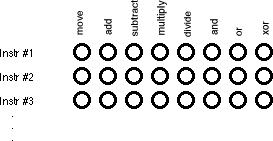
AX -The accumulator register BX -The base address register CX -The count register DX -The data register
Besides the above registers, which are visible to the programmer, the x86 processors also have an instruction pointer register which contains the address of the next instruction to execute. There is also a flags register that holds the result of a comparison. The flags register remembers if one value was less than, equal to, or greater than another value.
Because registers are on-chip and handled specially by the CPU, they are much faster than memory. Accessing a memory location requires one or more clock cycles. Accessing data in a register usually takes zero clock cycles. Therefore, you should try to keep variables in the registers. Register sets are very small and most registers have special purposes which limit their use as variables, but they are still an excellent place to store temporary data.

Of course, a major difficulty with this scheme is that the number of possible instructions is severely limited by the number of sockets one could physically place on each row. However, CPU designers quickly discovered that with a small amount of additional logic circuitry, they could reduce the number of sockets required from n holes for n instructions to lg(n) [log base 2] holes for n instructions. They did this by assigning a numeric code to each instruction and then encode that instruction as a binary number using lg(n) holes:
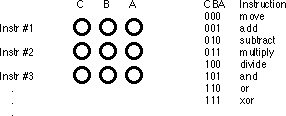
This addition requires eight logic functions to decode the A, B, and C bits from the patch panel, but the extra circuitry is well worth the cost because it reduces the number of sockets that must be repeated for each instruction.
Of course, many CPU instructions are not stand-alone. For example, the move instruction is a command that moves data from one location in the computer to another (e.g., from one register to another). Therefore, the move instruction requires two operands: a source operand and a destination operand. The CPU's designer usually encodes these source and destination operands as part of the machine instruction, certain sockets correspond to the source operand and certain sockets correspond to the destination operand. The figure below shows one possible combination of sockets to handle this. The move instruction would move data from the source register to the destination register, the add instruction would add the value of the source register to the destination register, etc.
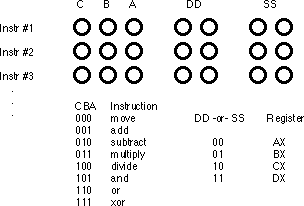
One of the primary advances in computer design that the VNA provides is the concept of a stored program. One big problem with the patch panel programming method is that the number of program steps (machine instructions) is limited by the number of rows of sockets available on the machine. John Von Neumann and others recognized a relationship between the sockets on the patch panel and bits in memory; they figured they could store the binary equivalents of a machine program in main memory and fetch each program from memory, load it into a special decoding register that connected directly to the instruction decoding circuitry of the CPU.
The trick, of course, was to add yet more circuitry to the CPU. This circuitry, the control unit (CU), fetches instruction codes (also known as operation codes or opcodes) from memory and moves them to the instruction decoding register. The control unit contains a special registers, the instruction pointer that contains the address of an executable instruction. The control unit fetches this instruction's code from memory and places it in the decoding register for execution. After executing the instruction, the control unit increments the instruction pointer and fetches the next instruction from memory for execution, and so on.
When designing an instruction set, the CPU's designers generally choose opcodes that are a multiple of eight bits long so the CPU can easily fetch complete instructions from memory. The goal of the CPU's designer is to assign an appropriate number of bits to the instruction class field (move, add, subtract, etc.) and to the operand fields. Choosing more bits for the instruction field lets you have more instructions, choosing additional bits for the operand fields lets you select a larger number of operands (e.g., memory locations or registers). There are additional complications. Some instructions have only one operand or, perhaps, they don't have any operands at all. Rather than waste the bits associated with these fields, the CPU designers often reuse these fields to encode additional opcodes, once again with some additional circuitry. The Intel 80x86 CPU family takes this to an extreme with instructions ranging from one to about ten bytes long. Since this is a little too difficult to deal with at this early stage, the x86 CPUs will use a different, much simpler, encoding scheme.
mov (two forms), add, sub, cmp, and, or, not, je, jne, jb, jbe, ja, jae, jmp, brk, iret, halt, get, and put. The following paragraphs describe how each of these work.mov instruction is actually two instruction classes merged into the same instruction. The two forms of the mov instruction take the following forms:
mov reg, reg/memory/constant
mov memory, reg
where reg is any of ax, bx, cx, or dx; constant is a numeric constant (using hexadecimal notation), and memory is an operand specifying a memory location. The next section describes the possible forms the memory operand can take. The "reg/memory/constant" operand tells you that this particular operand may be a register, memory location, or a constant.
The arithmetic and logical instructions take the following forms:
add reg, reg/memory/constant
sub reg, reg/memory/constant
cmp reg, reg/memory/constant
and reg, reg/memory/constant
or reg, reg/memory/constant
not reg/memory
The add instruction adds the value of the second operand to the first (register) operand, leaving the sum in the first operand. The sub instruction subtracts the value of the second operand from the first, leaving the difference in the first operand. The cmp instruction compares the first operand against the second and saves the result of this comparison for use with one of the conditional jump instructions (described in a moment). The and and or instructions compute the corresponding bitwise logical operation on the two operands and store the result into the first operand. The not instruction inverts the bits in the single memory or register operand.
The control transfer instructions interrupt the sequential execution of instructions in memory and transfer control to some other point in memory either unconditionally, or after testing the result of the previous cmp instruction. These instructions include the following:
ja dest -- Jump if above
jae dest -- Jump if above or equal
jb dest -- Jump if below
jbe dest -- Jump if below or equal
je dest -- Jump if equal
jne dest -- Jump if not equal
jmp dest -- Unconditional jump
iret -- Return from an interrupt
The first six instructions in this class let you check the result of the previous cmp instruction for greater than, greater or equal, less than, less or equal, equality, or inequality. For example, if you compare the ax and bx registers with the cmp instruction and execute the ja instruction, the x86 CPU will jump to the specified destination location if ax was greater than bx. If ax is not greater than bx, control will fall through to the next instruction in the program. The jmp instruction unconditionally transfers control to the instruction at the destination address. The iret instruction returns control from an interrupt service routine, which we will discuss later.
The get and put instructions let you read and write integer values. Get will stop and prompt the user for a hexadecimal value and then store that value into the ax register. Put displays (in hexadecimal) the value of the ax register.
The remaining instructions do not require any operands, they are halt and brk. Halt terminates program execution and brk stops the program in a state that it can be restarted.
The x86 processors require a unique opcode for every different instruction, not just the instruction classes. Although "mov ax, bx" and "mov ax, cx" are both in the same class, they must have different opcodes if the CPU is to differentiate them. However, before looking at all the possible opcodes, perhaps it would be a good idea to learn about all the possible operands for these instructions.
mov instruction:
mov ax, ax
mov ax, bx
mov ax, cx
mov ax, dx
The first instruction accomplishes absolutely nothing. It copies the value from the ax register back into the ax register. The remaining three instructions copy the value of bx, cx and dx into ax. Note that the original values of bx, cx, and dx remain the same. The first operand (the destination) is not limited to ax; you can move values to any of these registers.
Constants are also pretty easy to deal with. Consider the following instructions:
mov ax, 25
mov bx, 195
mov cx, 2056
mov dx, 1000
These instructions are all pretty straightforward; they load their respective registers with the specified hexadecimal constant.
There are three addressing modes which deal with accessing data in memory. These addressing modes take the following forms:
mov ax, [1000]
mov ax, [bx]
mov ax, [1000+bx]
The first instruction above uses the direct addressing mode to load ax with the 16 bit value stored in memory starting at location 1000 hex.
The mov ax, [bx] instruction loads ax from the memory location specified by the contents of the bx register. This is an indirect addressing mode. Rather than using the value in bx, this instruction accesses to the memory location whose address appears in bx. Note that the following two instructions:
mov bx, 1000
mov ax, [bx]
are equivalent to the single instruction:
mov ax, [1000]
Of course, the second sequence is preferable. However, there are many cases where the use of indirection is faster, shorter, and better. We'll see some examples of this when we look at the individual processors in the x86 family a little later.
The last memory addressing mode is the indexed addressing mode. An example of this memory addressing mode is
mov ax, [1000+bx]
This instruction adds the contents of bx with 1000 to produce the address of the memory value to fetch. This instruction is useful for accessing elements of arrays, records, and other data structures.
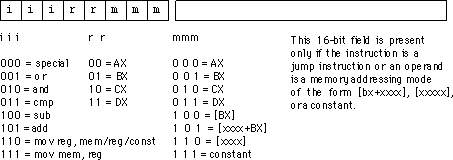
The basic instruction is either one or three bytes long. The instruction opcode consists of a single byte that contains three fields. The first field, the H.O. three bits, defines the instruction class. This provides eight combinations. As you may recall, there are 20 instruction classes; we cannot encode 20 instruction classes with three bits, so we'll have to pull some tricks to handle the other classes. As you can see above, the basic opcode encodes the mov instructions (two classes, one where the rr field specifies the destination, one where the mmm field specifies the destination), the add, sub, cmp, and, and or instructions. There is one additional class: special. The special instruction class provides a mechanism that allows us to expand the number of available instruction classes, we will return to this class shortly.
To determine a particular instruction's opcode, you need only select the appropriate bits for the iii, rr, and mmm fields. For example, to encode the mov ax, bx instruction you would select iii=110 (mov reg, reg), rr=00 (ax), and mmm=001 (bx). This produces the one-byte instruction 11000001 or 0C0h.
Some x86 instructions require more than one byte. For example, the instruction mov ax, [1000] loads the ax register from memory location 1000. The encoding for the opcode is 11000110 or 0C6h. However, the encoding for mov ax,[2000]'s opcode is also 0C6h. Clearly these two instructions do different things, one loads the ax register from memory location 1000h while the other loads the ax register from memory location 2000. To encode an address for the [xxxx] or [xxxx+bx] addressing modes, or to encode the constant for the immediate addressing mode, you must follow the opcode with the 16-bit address or constant, with the L.O. byte immediately following the opcode in memory and the H.O. byte after that. So the three byte encoding for mov ax, [1000] would be 0C6h, 00h, 10h and the three byte encoding for mov ax, [2000] would be 0C6h, 00h, 20h.
The special opcode allows the x86 CPU to expand the set of available instructions. This opcode handles several zero and one-operand instructions as shown in the following two figures:
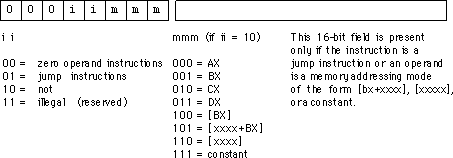
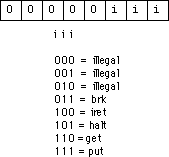
There are four one-operand instruction classes. The first encoding (00) further expands the instruction set with a set of zero-operand instructions. The second opcode is also an expansion opcode that provides all the x86 jump instructions:
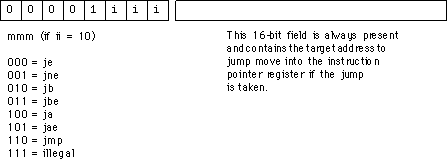
The third opcode is the not instruction. This is the bitwise logical not operation that inverts all the bits in the destination register or memory operand. The fourth single-operand opcode is currently unassigned. Any attempt to execute this opcode will halt the processor with an illegal instruction error. CPU designers often reserve unassigned opcodes like this one to extend the instruction set at a future date (as Intel did when moving from the 80286 processor to the 80386).
There are seven jump instructions in the x86 instruction set. They all take the following form:
jxx address
The jmp instruction copies the 16-bit immediate value (address) following the opcode into the IP register. Therefore, the CPU will fetch the next instruction from this target address; effectively, the program "jumps" from the point of the jmp instruction to the instruction at the target address.
The jmp instruction is an example of an unconditional jump instruction. It always transfers control to the target address. The remaining six instructions are conditional jump instructions. They test some condition and jump if the condition is true; they fall through to the next instruction if the condition is false. These six instructions, ja, jae, jb, jbe, je, and jne let you test for greater than, greater than or equal, less than, less than or equal, equality, and inequality. You would normally execute these instructions immediately after a cmp instruction since it sets the less than and equality flags that the conditional jump instructions test. Note that there are eight possible jump opcodes, but the x86 uses only seven of them. The eighth opcode is another illegal opcode.
The last group of instructions, the zero operand instructions, appear in a figures above. Three of these instructions are illegal instruction opcodes. The brk (break) instruction pauses the CPU until the user manually restarts it. This is useful for pausing a program during execution to observe results. The iret (interrupt return) instruction returns control from an interrupt service routine. We will discuss interrupt service routines later. The halt program terminates program execution. The get instruction reads a hexadecimal value from the user and returns this value in the ax register; the put instruction outputs the value in the ax register.
mov reg, reg/memory/constant instruction:
ip register to point at the next byte.ip to point beyond the operand.A step-by-step description may help clarify what the CPU is doing. In the first step, the CPU fetches the instruction byte from memory. To do this, it copies the value of the ip register to the address bus and reads the byte at that address. This will take one clock cycle.
After fetching the instruction byte, the CPU updates ip so that it points at the next byte in the instruction stream. If the current instruction is a multibyte instruction, ip will now point at the operand for the instruction. If the current instruction is a single byte instruction, ip would be left pointing at the next instruction. This takes one clock cycle.
The next step is to decode the instruction to see what it does. This will tell the CPU, among other things, if it needs to fetch additional operand bytes from memory. This takes one clock cycle.
During decoding, the CPU determines the types of operands the instruction requires. If the instruction requires a 16 bit constant operand (i.e., if the mmm field is 101, 110, or 111) then the CPU fetches that constant from memory. This step may require zero, one, or two clock cycles. It requires zero cycles if there is no 16 bit operand; it requires one clock cycle if the 16 bit operand is word-aligned (that is, begins at an even address); it requires two clock cycles if the operand is not word aligned (that is, begins at an odd address).
If the CPU fetches a 16 bit memory operand, it must increment ip by two so that it points at the next byte following the operand. This operation takes zero or one clock cycles. Zero clock cycles if there is no operand; one if an operand is present.
Next, the CPU computes the address of the memory operand. This step is required only when the mmm field of the instruction byte is 101 or 100. If the mmm field contains 101, then the CPU computes the sum of the bx register and the 16 bit constant; this requires two cycles, one cycle to fetch bx's value, the other to computer the sum of bx and xxxx. If the mmm field contains 100, then the CPU fetches the value in bx for the memory address, this requires one cycle. If the mmm field does not contain 100 or 101, then this step takes zero cycles.
Fetching the operand takes zero, one, two, or three cycles depending upon the operand itself. If the operand is a constant (mmm=111), then this step requires zero cycles because we've already fetched this constant from memory in a previous step. If the operand is a register (mmm = 000, 001, 010, or 011) then this step takes one clock cycle. If this is a word aligned memory operand (mmm=100, 101, or 110) then this step takes two clock cycles. If it is an unaligned memory operand, it takes three clock cycles to fetch its value.
The last step to the mov instruction is to store the value into the destination location. Since the destination of the load instruction is always a register, this operation takes a single cycle.
Altogether, the mov instruction takes between five and eleven cycles, depending on its operands and their alignment (starting address) in memory.
The CPU does the following for the mov memory, reg instruction:
ip to point at the next byte (one clock cycle).ip to point beyond the operand (zero cycles if no such operand, one clock cycle if the operand is present).The timing for the last two items is different from the other mov because that instruction can read data from memory; this version of mov instruction "loads" its data from a register. This instruction takes five to eleven clock cycles to execute.
The add, sub, cmp, and, and or instructions do the following:
ip to point at the next byte (one clock cycle).ip to point beyond the constant operand (zero or one clock cycles).These instructions require between eight and seventeen clock cycles to execute.
The not instruction is similar to the above, but may be a little faster since it only has a single operand:
ip to point at the next byte (one clock cycle).ip to point beyond the constant operand (zero or one clock cycles).The not instruction takes six to fifteen cycles to execute.
The conditional jump instructions work as follows:
ip to point at the next byte (one clock cycle).ip to point beyond the address (one clock cycle).ip register (zero cycles if no branch, one clock cycle if branch occurs).
The unconditional jump instruction is identical in operation to the mov reg, xxxx instruction except the destination register is the x86's ip register rather than ax, bx, cx, or dx.
The brk, iret, halt, put, and get instructions are of no interest to us here. They appear in the instruction set mainly for programs and experiments. We can't very well give them "cycle" counts since they may take an indefinite amount of time to complete their task.